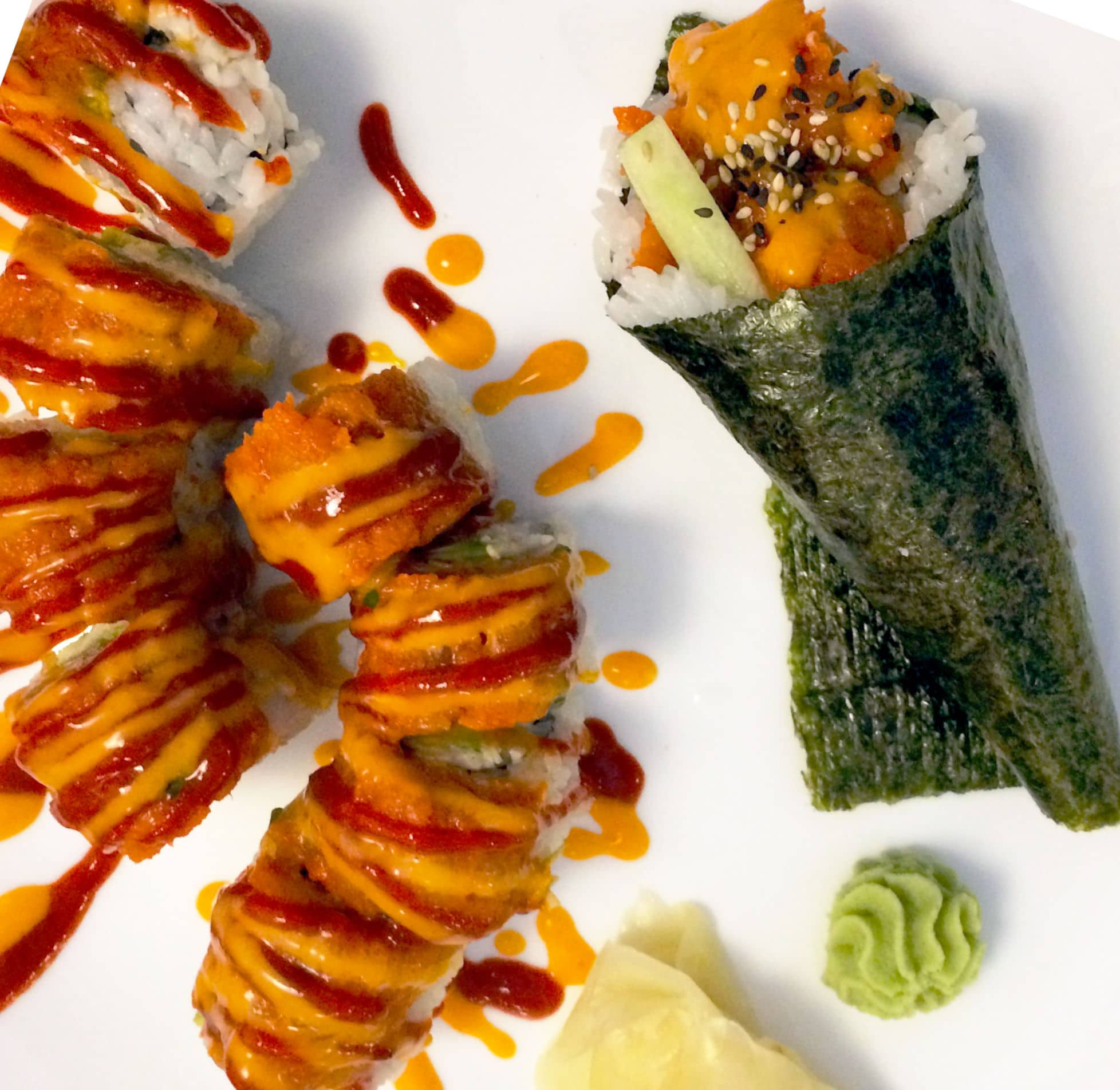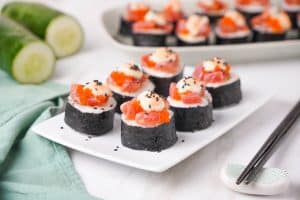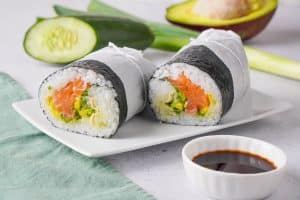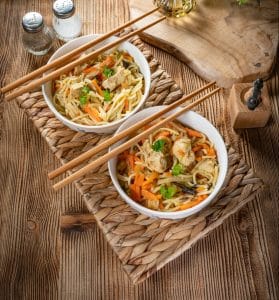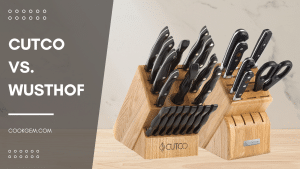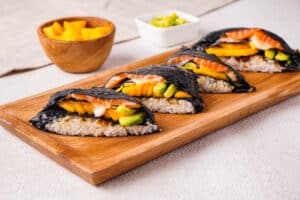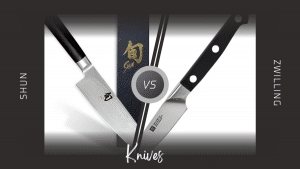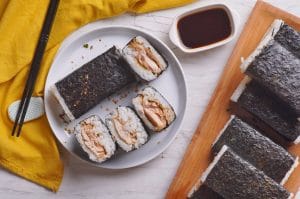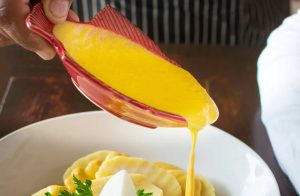Cut Roll vs. Hand Roll Sushi: What’s The Difference?
Important Note: When you buy through our links, we may earn a commission. As an Amazon Associate we earn from qualifying purchases. Content, pricing, offers and availability are subject to change at any time - more info.
Cutt rolls and hand rolls are the two most common forms of sushi encountered. Once you know the exact differences between these two tasty forms of nori-rolled cuisine, you’ll always know what to order without confusion. We’ll be taking you through a complete overview of cut roll vs. hand roll sushi, breaking down all the highlights, common ingredients, terminology and differences.
What Is A Cut Roll?
A cut roll is one of the most common forms of sushi served. Cut rolls are made by rolling a sheet of nori, or seaweed, layered with short-grain rice treated with rice vinegar atop which fish, herbs, vegetables, and other fillings are placed. The chef rolls the layered nori with the help of a makisu or Japanese bamboo mat that helps them reach a tight, even shape. Once formed, the cut roll is then sliced into segments.
What Is A Hand Roll?
A hand roll is a medium-sized form of sushi that’s shaped to be eaten by hand. Hand rolls are made with nori rolled into a conical shape that holds vinegar-treated sushi rice, toppings like fish, shellfish, vegetables, and other fillings. No specialized equipment is needed to form a hand roll which is packed tight but far more loosely than a cut roll. Each hand roll is served whole. It’s a delicious way to eat sushi, if you haven’t tried it you should try it once in your life.
Cut Roll vs. Hand Roll – Comparison
| Cut Roll | Hand Roll | |
| Names | Cut Roll, Makizushi, Maki, Makinori, Nori Maki | Hand Roll, Temakizushi |
| Shape | Tubular/Cylindrical | Conical |
| Serving Size | Eight Inches Cut Into Six to Eight Segments | Eight Inches – Single Roll |
| Culinary Difficulty | High Difficulty – Bamboo Mat & Expertise Needed | Zero Difficulty |
| Ingredients/Filling | Simple Fillings – Seafood In Vinegared Rice & Nori | All Varieties, Greater Number Of Fillings Possible |
| Varieties | Named By Traditional Variety, Rolling Method & By Size: Hosomaki (Small) – Nakamaki (Medium) – Chumaki (Large) – Futomaki (Extra-Large) | Traditional & Non-Traditional Recipes |
| Eating Preference | Using Chopsticks, Two People | By Hand, Using One Hand – One Person |
Cut Roll
Most of us think of a cut roll when we think of sushi. Here is a close look at what makes cut rolls so delicious and unique.
Names
Sushi’s staple, a cut roll, is termed makizushi. The name maki is derived from the Japanese word ‘maku,’ which translates to ‘wrap’ or ‘coil,’ referring to the unmistakable tubular shape, while ‘zushi’ is ‘sushi’ conjugated. Most people call makizushi, maki, makinori, or nori maki.
Shape
Cut rolls are cylindrical, shaped under precise pressure using a bamboo mat to be perfectly round and filled equidistantly from the center and evenly.
Serving Size
Hosomaki makizushi cut rolls, the variety most commonly found, are eight inches in length. Each uses a full sheet of nori which is then cut into six to eight pieces. Every cut roll measures roughly an inch in diameter on average. Larger cut rolls like futomaki that include four ingredients or more are typically cut into four pieces measuring roughly 2-inches in diameter each.
Culinary Difficulty
Cut rolls are far more difficult to roll than hand rolls. Precision and practiced expertise with rolling nori using a bamboo mat are essential to forming a tight, evenly packed maki roll, giving makizushi an unavoidable learning curve.
Ingredients/Filling
Traditional Japanese sushi keeps cut rolls simple, relying on a handful of ingredients that accentuate the fish wrapped to perfection in nori. Fish such as yellowtail, tuna, salmon, snapper, whitefish, or eel are wrapped in nori layered with vinegared rice. The outside of the roll is often lightly coated with sesame seeds, masago, or roe. Westernized sushi and more modern varieties incorporate a broad range of ingredients and filling styles, each layered against a sheet of seaweed and rice treated with rice vinegar.
Cut Roll Varieties
Cut rolls can be classified according to their three basic sizes:
Hosomaki – Hosomaki are the smallest variety of cut rolls and utilize a single filling (and rice) to reach an extremely thin bite-sized shape of an inch in diameter or less.
Nakamaki – Nakamaki are medium-sized cut rolls, using two to three fillings (and rice) to keep to a diameter that’s only slightly larger than hosomaki.
Chumaki – Chumaki measures an inch and half in diameter on average, putting these cut rolls midway between nakamaki and a conservative futomaki while including two to three ingredients and four if extremely tightly rolled.
Futomaki – At double the size of hosomaki or bigger, Futomaki are the largest cut rolls incorporating four or more fillings (and rice) while reaching 2 ½ inches in diameter.
There are also several types of maki that refer directly to the ingredients used and/or the rolling method:
Tekkamaki – Tekkamaki includes raw sushi-grade tuna.
Kappamaki – Kappamaki uses cooked tuna and mayonnaise.
Nattomaki – Nattomaki is based around fermented soybeans.
Shinkomaki – Shinkmaki are filled with pickled yellow daikon radishes.
Kanpyomaki – Kanpyomaki are the traditional form of Edomae-zushi (sushi made with marinated raw fish, shellfish, or vegetables) and include a dried ripe marinated gourd and other ingredients like minced prawn and mirin.
Ehomaki – Ehomaki is a cut roll traditionally consumed on the evening of the Japanese religious holiday Setsubun that celebrates the day before the start of spring in Japan’s old calendar. While Ehomaki has no fixed recipe, it normally includes seven different ingredients honoring the Seven Gods of Fortune. Boiled shiitake mushrooms, egg, and kabayaki (unagi eel and other fish marinated in sweet soy sauce) feature frequently as popular choices.
Gunkanmaki – Better known as ‘Battleship Sushi’ referring to its shape built from a long strip of nori that acts as a boat-shaped bowl for ingredients like ikura (salmon roe), kazunoka (salted herring roe), tobiko (flying fish roe), or uni (sea urchin.)
Uramaki – Uramaki is better known as an inside-out sushi roll, referring to the way that the cut roll is built backward with nori on the inside and rice on the outside. Various toppings are placed atop the roll instead of
Makizushi Eating Preference
The cut, shape, and size of makizushi are qualities that make this the definitive type of sushi meant to be eaten using chopsticks. It’s also large enough to be shared by two people.
Hand Roll
With a sheet of nori and the right vinegar and rice, just about anyone can make a tasty hand roll at home. Here are the main characteristics of this easy-to-make easy-to-eat form of sushi.
Names
Hand rolls are called temaki sushi and are also referred to as temakizushi. The word ‘te’ is hand, and ‘maki’ translates to roll in Japanese, therefore literally meaning ‘hand roll’ with conjugation of sushi for the term ‘temakizushi.’
Shape
Most hand rolls are conical to some degree, making them easy to hold with one hand while preventing any of the fillings from falling out.
Serving Size
Most restaurants serve hand rolls made from half a sheet of nori measuring roughly 3.5″ x 4″ while those cooking at home often prefer a quarter sheet instead. One hand roll typically fills a full single portion size.
Culinary Difficulty
Hand rolls are far easier to roll together than tightly packed cut rolls. No special expertise or equipment is necessary. As the option traditionally made at home to familiarise newcomers to the delicacy with sushi, temaki is easy to make and requires little precision. The cone-shaped rolled nori forms a pocket that’s supremely easy to fill with any ingredients preferred.
Ingredients/Fillings
Hand rolls generally incorporate more ingredients than cut rolls. Four ingredients or more are common. From an assortment of sashimi, caviar, and other seafood to egg, kaiware (daikon sprouts), nagaimo (mountain yam), and other non-traditional offerings like asparagus, cooked beef, pork, or chicken, hand rolls can be filled with just about anything.
Hand Roll Varieties
Unlike cut rolls, hand rolls will list their ingredients or be available as an alternative to a named cut roll, therefore including the same ingredients as the maki on offer. Expect to find anything you’d find in a cut roll in hand rolls as well. It’s also far more common to find non-traditional ingredients like cooked, marinated meat and non-eastern vegetables like peas and avocado.
Temaki Eating Preference
Hand rolls are literally made to be eaten by hand. There’s no need for chopsticks or any other cutlery. Each hand roll is made to feed one person only.
What Is The Difference Between A Hand Roll And A Cut Roll?
The main difference between the two is the balance of ingredients that’s typically served up. Any reputable restaurant will, hopefully, be serving up equal quality cut rolls and hand rolls. Both can be filled to a fulfilling well-packed density, but there’s no comparing to the skill that it takes to make perfect makizushi. The Japanese art of sushi prides itself on the techniques in action seen on the best cut rolls around. We suggest starting with hand rolls if you’re making sushi at home and working your way towards cut rolls as you grow more accustomed to traditional ingredients and rolling methods.
